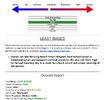I'm not entirely certain regarding the weather that night but l am familiar with flying into Catalina and if memory serves departure is always to the west. The place I used to rent airplanes from required a "checkout" with an instructor to take a plane across the 26 miles of water, and the airport was not the only peculiarity regarding flying there from Santa Monica, Burbank or Van Nuys. They wanted to make sure you comfortably knew how to operate through the VFR LAX corridor safely. Obviously I never flew to Catalina at night but I can imagine what the departure might've looked like. When I was still working on my PPL I had to do a few hours of dual night cross country so my instructor and I agreed to fly down to Palomar, land and then head back to Burbank late one night. The flight down in the 152 was spectacular with the lights from the urban sprawl spreading in all directions. I successfully navigated to and landed at Palomar at night with zero issues, I was kind of proud of myself. Here's where I suspect my instructor had a plan to humble me. As a student I'd draw up detailed flight plans using my E6-B, radials, winds and any other variable a 152 might encounter and it had to be approved by the instructor before we took off. Being full of myself that evening I stamped out my cigarette under my Nike shoe and suggested it was getting late and we ought to start heading home. I'm fairly certain I walked up to that 152 like a Spitfire pilot during the Battle of Britain. We started up, taxied out and took off to the west, my meticulous flight planning would take us over the beach and then intercept a radial a couple miles off shore that would lead us straight back to the LAX corridor and get us home. I was not training for my instrument rating, I was just checking boxes for my Private, in other words despite my fine motor skills and bravado and the fact that I had soloed I was not quite a pilot yet and I think my instructor wanted to hammer that point home. Everything was going perfectly, my trusty 152 was running perfect, the take-off was text book perfect and as we climbed we crossed the shoreline and it was as if someone tossed a blanket over the windscreen, there was no horizon or stars it was just black. I recall looking back through the back windows and feeling very melancholy about the lights behind me and being very uncertain about my future. And then I remembered I was not alone, my savior and I were actually rubbing shoulders, I quickly confessed my discomfort with our current situation. This is what leads me to believe he knew this was going to happen, he was just chilling and asked me to pay attention to the instruments and figure it out. I immediately threw my flight plan to the wind, slowly turned the airplane north and decided on a more acceptable course that would allow me to have the shoreline a bit closer as a reference as we traveled home.
It's a lot of words to say taking off to the west at night over the Pacific Ocean can be disconcerting and this person would not have had the benefit of a metropolis of lights behind him to give any reference. You can't see Hawaii from Catalina.


